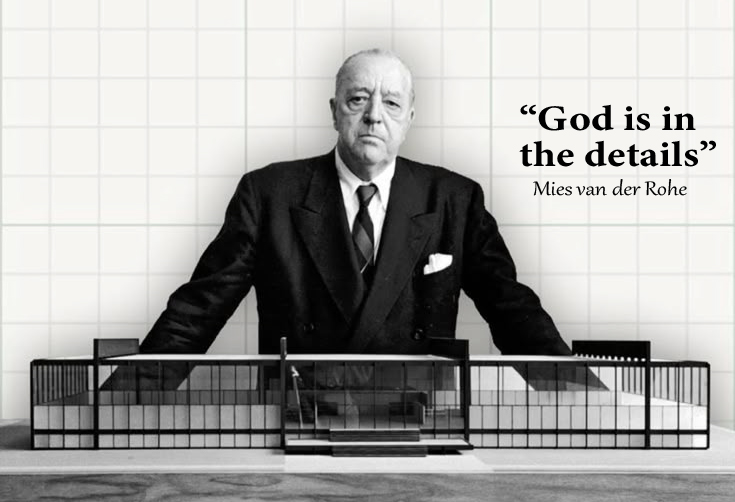by: Arc. Biola Akinola, mnia

The phrase “God Is In The Details” is commonly attributed to the renowned architect Ludwig Mies van der Rohe, although its origins are debated. It suggests that paying close attention to intricate elements leads to excellence and beauty, a principle that resonates deeply within the fields of arts and architecture. We’ll be exploring this maxim today, highlighting its significance across different disciplines and historical contexts.

ORIGIN OF THE PHRASE
While Ludwig Mies van der Rohe popularized the phrase, it may have evolved from earlier sayings like “the devil is in the details,” which conveyed the idea that small details can derail a project. Mies van der Rohe, a pioneer of modernist architecture, believed that simplicity and clarity were essential to good design. His famous dictum “Less is more” complements “God is in the Details”, suggesting that minimalism, when executed with precision, can achieve profound beauty and functionality. Mies used the phrase to emphasize that the soul of a building or work of art resides in the precision and craftsmanship of its finer elements.
In both interpretations, the emphasis is on details – whether they bring harmony and perfection (“God”) or become pitfalls (“devil”). Mies’ version, however, celebrates the artistry and care necessary in designing both functional and aesthetically pleasing works.

THE IMPORTANCE OF DETAIL IN ARCHITECTURE
Architecture is the marriage of form and function, and it is through meticulous attention to detail that these two elements reach their full potential. Whether it’s the choice of materials, the junctions between surfaces, or how light interacts with space, details define the experience of a structure.
- Craftsmanship
Craftsmanship plays a critical role in architectural detailing. The way materials are handled, joined, and finished can make a significant difference in how a building is perceived. Mies van der Rohe’s designs, for example, were known for their rigorous attention to the way materials were used — how steel met glass or how walls interacted with the environment.
In Frank Lloyd Wright’s Fallingwater, the seamless integration of the building with its natural surroundings exemplifies the power of details. The choice of stone that mirrors the surrounding rock formations, the waterfall that flows underneath the house, and the cantilevered terraces all reflect how Wright used details to create harmony between architecture and nature.
- Materiality and Texture
Materiality is another aspect of detailing in architecture. The texture, color, and tactile quality of materials must be carefully considered to convey meaning and evoke emotions. Architects who pay attention to the detail of how different materials are juxtaposed often create spaces that are both visually engaging and harmonious to inhabit.
In Renzo Piano’s Shard in London, the use of glass to create a reflective, translucent structure speaks to the detail-oriented approach that creates the building’s striking effect on the skyline.
- Structural Integrity and Aesthetics
In architecture, details are crucial for both structural integrity and aesthetic appeal as exemplified in the case studies below:
- Farnsworth House: The Farnsworth House is a prime example of how “God is in the Details” manifests in architecture. Located in Illinois, this minimalist structure uses a steel frame and large glass panels to create an open, airy space that blurs the line between indoors and outdoors. The precision in the construction of the steel frame and the careful selection of materials highlight the importance of details in achieving Mies’s vision.
- The Looking Glass: Another notable example is the P.C. Hooftstraat 138 in Amsterdam, designed by UNStudio. This building features a facade with curved glass panels that mimic the appearance of flowing fabric. The intricate design and execution of these glass elements demonstrate how attention to detail can transform a building’s exterior into a work of art.

DETAILS IN THE ART: FROM MICHAEL ANGELO TO MODERNISM
In the world of both fine and decorative arts, the idea of “God is in the details” also applies. Masterpieces in painting, sculpture, and even contemporary digital art often exhibit a level of precision that elevates the work from mere creation to transcendence.
In fine arts , details can convey deeper meanings and evoke stronger emotional responses. Artists like Leonardo da Vinci and Michelangelo were known for their meticulous attention to detail, which allowed them to create lifelike and expressive works. For instance, the delicate rendering of textures and subtle variations in colour in da Vinci’s “Mona Lisa” contribute to the painting’s enigmatic quality.
In the decorative arts, details play a crucial role in the overall design and craftsmanship of objects. From intricate patterns on ceramics to elaborate carvings on furniture, these details reflect the skill and creativity of the artisans. The Art Nouveau movement, for example, is characterized by its use of organic forms and intricate details, which create a sense of fluidity and movement in the designs.
- Renaissance Art
The Renaissance period exemplifies this attention to detail, particularly in the works of artists like Michelangelo and Leonardo da Vinci. Michelangelo’s David is not only celebrated for its overall form but also for the minutiae—the veins in David’s hands, the tension in his muscles, and the lifelike expression on his face. Each detail was carefully crafted to bring the sculpture to life, emphasizing the divinity in human form.
Leonardo da Vinci’s Mona Lisa is another prime example where the finest details, such as the subtle smile and the delicate use of sfumato (a technique of blending colours and shades), contribute to the painting’s ethereal quality.
- Modern and Contemporary Art
In the modern era, artists like Piet Mondrian took a minimalist approach, yet the importance of detail remained crucial. Mondrian’s abstract works, like Composition with Red, Blue, and Yellow, relied on the precision of colour placement, line, and form to achieve balance. Though simple in appearance, it was the careful attention to spatial relationships that gave his work depth and meaning.
Contemporary artists and digital creators continue this tradition, using tools that allow them to refine details at microscopic levels. In large installations or digital renderings, the subtle integration of light, texture, and space can transform a viewer’s experience.
DETAILS AS COMMUNICATION: EMOTIONAL AND SYMBOLIC WEIGHT
Details in architecture and art do more than add visual appeal; they often serve as a form of communication, conveying emotional and symbolic messages.
- Emotional Impact
In architecture, details can affect the emotional resonance of a space. The height of a ceiling, the size of a window, or the curve of a stairway can evoke feelings of openness, intimacy, or grandeur. For example, the intricate carvings in Gothic cathedrals, such as the Notre-Dame, not only exhibit technical mastery but also serve to inspire awe and reverence, leading the viewer toward a spiritual experience.
Similarly, in art, small details can communicate intense emotion. In Vincent van Gogh’s Starry Night, the swirling sky and thick brushstrokes convey a sense of turbulence and emotion that speak beyond the literal depiction of the scene.
- Symbolism in Detail
Architectural and artistic details are often imbued with symbolic meaning. In traditional Islamic architecture, the complex geometric patterns found in tiles, carvings, and screens represent the infinite nature of Allah. These details not only enhance the aesthetic but also create a sense of spiritual contemplation.
In contrast, minimalist architecture often strips away overt symbolism but pays extreme attention to how materials, light, and space interplay to create environments that feel pure and harmonious. In this sense, the absence of unnecessary detail becomes a powerful statement of clarity and purpose.

TECHNOLOGICAL INFLUENCE ON DETAILING
Modern technology has transformed how architects and artists approach detailing. With advancements in design software and construction techniques, designers can now achieve a level of precision that was previously unimaginable.
- Parametric Design
Parametric design allows architects to manipulate complex shapes and patterns in ways that rely heavily on detailed algorithms and data. Structures like Zaha Hadid’s Heydar Aliyev Centre in Azerbaijan use smooth, flowing forms that require an intense focus on how each part of the structure integrates seamlessly with the whole.
- 3D Printing and Digital Fabrication
In both art and architecture, 3D printing and digital fabrication techniques have revolutionized detailing. Artists can now create highly intricate forms, impossible by hand, with fine-tuned precision. Similarly, architects can design and produce custom building components that fit together with flawless accuracy.
CONCLUSION: THE DIVINE IN THE DETAILS
The phrase “God is in the Details” underscores the significance of paying attention to the smallest elements in both arts and architecture. Whether it’s the precise alignment of structural components in a building or the delicate brushstrokes in a painting, these details can greatly enhance the overall impact and quality of the work. By embracing this principle, artists and architects can create pieces that are not only functional and beautiful but also deeply meaningful and resonant.
It emphasizes the idea that mastery and beauty arise from careful, deliberate attention to the smallest elements. Whether in architecture or art, details play an essential role in shaping not only the aesthetic and functional qualities of a work but also the emotional and symbolic experiences it evokes.
In both disciplines, details are more than technical elements — they are the soul of the work. As we explore the meaning of this phrase, we come to understand that it is through the details that creativity, innovation, and divinity are realized, transforming ordinary designs into extraordinary creations.
Discover more from dorted
Subscribe to get the latest posts sent to your email.









